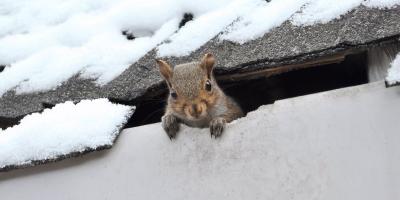Top 10 Pest Prevention Tips for Homeowners

Summer is in full swing and pest pressures continue to build with increasing temperatures. Many of our regional pests are attracted to specific conditions that exist in and around your home. Some of these conditions contribute to pest breeding sites and others provide access, food, and shelter. Here the Top 10 most common property defects that lead to pest invasion and infestation:
- Uncapped chimneys: Open chimney ways allow for a variety of animals including bats, squirrels, and raccoons to nest and possibly enter the home through cleanouts and open dampers.
Solution: Cap all chimneys. - Open gable vents, soffits, and eaves: Any opening around the roofline caused by age, damage, or shotty construction will lead to pest invasion from bats and wasps to stink bugs and cluster flies.
Solution: Repair or seal all roofline structural deficiencies. - Loose fitting or torn window screens: The most common entry points for flying and crawling insects such as wood roaches, moths, flies, mosquitoes, and beetles are open windows with poorly fitted or torn screens.
Solution: Make sure all window screens are properly fitted and without deficiencies. - Doors with gaps greater than ¼ inch: Believe it or not doors, (including garage & bulkhead doors), are major highways into your home for rodents and a wide variety of spiders and insects.
Solution: Tight fitting doors will prevent most pests from entering your home through these access points. Gaps of ¼ inches or more will permit mice to enter. - Foundation openings: Foundation openings created by pipes, wires, or damage give many types of pests direct access to the inside of your home. If openings exceed ½ inch, then rats can enter. All foundation opening give access to most insects and spiders.
Solution: Foundation gaps, cracks, openings, and damage must be properly sealed or repaired to keep the critters outside where they belong. - Clogged rain gutters: Clogged rain gutters and downspouts are prime breeding and harborage sites for many insect pests such as mosquitoes, carpenter ants, household ants, springtails, beetles, and cockroaches.
Solution: Clear all fallen debris from gutters periodically each year. Frequency depends on the proximity of the tree line around the home. Best times to clear the gutters include after snow melt in the spring, after pollen season in early summer, and after leaf drop in late autumn and before the deep freeze. - Overhanging tree limbs/branches: Tree branches that are low hanging or touching the roof or siding provide easy access for crawling insects such as carpenter ants to become a problem. Additionally, these low hanging limbs and branches allow squirrels to gain access to your roof and search for possible overwintering nest sites.
Solution: Trim back limbs and branches so that they do not touch the structure or provide an easy bridge for squirrels and raccoons. - Overgrown foundation shrubbery: Once foundation planted shrubbery becomes dense and overgrown, it will contribute to many pest problems in and around the home. Shrubbery that grows against the siding and under the soffits will enable ants, spiders, wasps, aphids, plant sucking insects, termites, birds, and so many other species to become problematic.
Solution: At some point, overgrown shrubbery should be removed, and new foundation plantings should be avoided. Trimming back dense shrubbery at least 18 inches from the walls will help allow the house to breath and provide a better line of sight for inspections. - Leaf debris and dense weeds: Leaf debris serves as hiding and nesting sites for so many types of pests including deer ticks, beetles, cockroaches, millipedes, springtails, pillbugs, mice, and more. Weedy areas of the property are where ticks like hide wait for their next host.
Solution: Remove leaf debris away from the foundation periodically as needed. Keep weedy areas under control throughout the growing season. Mow grass regularly during the growing season to prevent ticks from moving into people and pet zones.
Miscellaneous conditions:
- Mosquitoes need stagnant water to breed.
Solution: Seek out items that collect water and drain them weekly or more frequently to prevent larval development and egg laying. Bird baths, plant pots, tree holes, broken sprinkler heads, tarps, bottle caps, children’s toys, pet bowls are all potential sources of water collection. - Wood piles attract an array of pests including carpenter ants, ticks, and mice.
Solution: Keep wood piles off the ground and at least 15 feet from the home. - Siding in direct contact with the soil can create so many issues for the home including moisture, mold, and rot issues that can also attract carpenter ants and termites to the structure.
Solution: Siding should be at least 12 inches off the ground.
Solution: There should be at least 6 inches of exposed foundation all around the home.
At JP Pest Services, our expertly trained Service Professionals know how to identify conditions around and inside your home that contribute to or can lead to a serious pest infestation. Managing these pest conducive conditions is a big part of Integrated Pest Management (IPM) and requires homeowner participation to defeat and prevent pest infestations. Please contact our team today to get started 800-222-2908.



